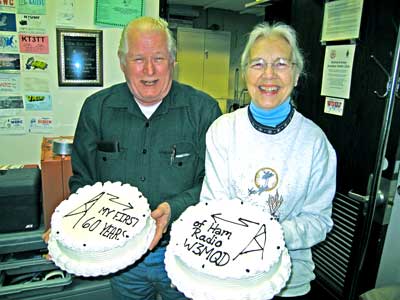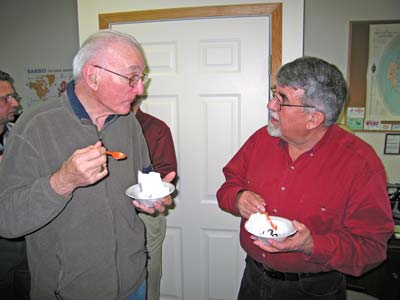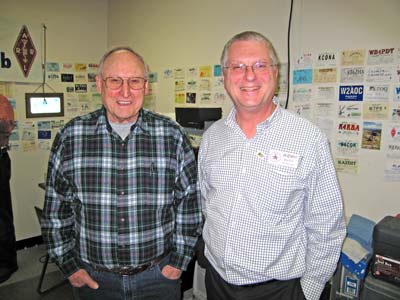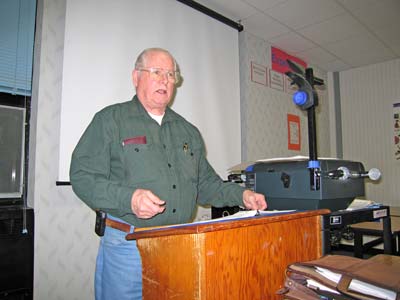 |
| United We Stand |
|
|
Brainerd Area Amateur Radio Club |
|
Club Membership Meeting on Thursday, January 25, 2007 |
 |
John W3MQD and his bride Vi provide cake and ice cream for everyone in celebration of John's "First 60 years of Ham Radio." |
 |
Ed KAØEXB and Fritz WØKO enjoying ice cream. |
 |
Jim WØJDS and Mark WØMH |
 |
A couple of cut-ups with their ice cream. Paula WØHA and Terry KIØFW. |
 (John W3MQD at the podium) Let me share some of the historical highlights beginning in: 1896 - My dad, Alfred N. Myers, was born in Westminster, MD, & my mom, Mary Virginia Elmore, was born in Cincinnati, Ohio. 1898 - Sinking of the "USS Maine," and the beginning of the Spanish-American War. 1901 - From Cornwall, England, Guglielmo Marconi repeatedly sent the letter S in Morse code, and it was received on an antenna connected to a kite flying 400 feet above St. John's, Newfoundland, a distance of 2,000 miles, marking the first trans-Atlantic successful radio transmission. 1906 - Christmas Eve voices over the air waves were heard for the first time. President Bush said the centennial of Reginald Fessenden's landmark voice broadcast "opened the door for technological advances" that improved the lives of people around the world. 1908 - Mom lost her mother at the age of 12, and went to live with her sister, also in Ohio. 1910 - Dad lost an eye in a blacksmith shop in Westminster, MD, in an accident while pounding red-hot iron, at 14, in the 8th grade. Can you imagine trying to feed solder to a wire and holding that American Beauty 100-watt iron together without the benefit of stereo vision? Dad quit school because of that accident. 1914 - ARRL was organized. 1917 - WW I for the US began. 1918 - Dad lost his two sisters and became an only child. Mom lost her 1st husband in the war. Paul Engler, a relative from my home town, lived to be 106 years old and was a US Army Radio Signalman in France. On November 10th, Paul heard a voice message on his radio for the first time. That message was that the next day at 11AM an armistice “will be signed between the Allies and Germany." Thus, WW I ended. 1921 - Dad was 6' tall and about 200 pounds, working on the Western Maryland Railway as an Electrical Signalman when he was scouted by a coach for Lynchburg College and offered a scholarship to play football there. Dad got his ham license and met Mom. Then they got married. Upon completing their 1st year, he became Captain of the football team, completed his high school equivalency, had one of the 1st broadcast receivers in town and listened to WRVA in Richmond, VA. They gave birth to 2 sons, he got his bachelor’s in teaching--all in 4 years. His first call sign was 3API. Later, because of international treaties, his call sign changed to W3API. Incidentally, Lynchburg, VA, became the home of GE's Land Mobile Division operation, and later their cell phone engineering and manufacturing. They were sold twice and the last owner is Sony. 1925 - Mom gave birth to another son. Dad taught in a boarding school in the mountains of western Virginia where the only access was by rail, then by horse-drawn carriage across the mountain to the school. 1926 - Things got better when Dad got a teaching job in Rustburg, VA, Public Schools. 1927- Mom had another child, John P. Myers, there in Rustburg, VA. 1929 - The Depression hit and Dad lost his job. We then went back to Westminster, his birthplace, and then to Emmitsburg, MD, where his mom and dad lived on her father's farm. 1931 - W3API accepted the job as Principal of Brookneal High School in Virginia and Elmered Benny Ginther there, who is still listed in QRZ as licensed ham KB4WHW. 1934 - My brothers and I helped Dad install one of the 1st school PA systems. I helped because I was the smallest and could crawl in the attic and pull the wire from each speaker and send it back down to the principal’s office for that system. 1937 - Dad's father died tragically and we moved back to Maryland to be close to his mother, then widowed. 1938 - Dan Noble of the University of Connecticut designed and Fred Link built the first successful two-way FM mobile radios for the State Police there. 1939 - One of my brothers, Joe, and I worked to learn the code and the other elements for our ham tickets. We didn't quite make it at that time. 1941 - December 7th came. When it was reported that the Japanese airplanes, using radio direction finders, had followed their way to the broadcast station in Honolulu to bomb Hickum Field and our fleet, all amateur radio operations ceased until the end of WW II. 1942 - I became an Air Raid Warden. As a Boy Scout I helped organize some of us to use a code sending light to communicate via Morse code between high points in town to signal if we were being invaded by the enemy by land, sea, or air. You see, we were living in the East, and those German subs were right off the coast. The physics teacher that year was in need of assistance in electricity lab, so I stepped up, and one of the experiments was sending a short-range signal wirelessly to a receiver using a coherer-detector in the receiver. In case you are not up on that technology, it uses a glass tube containing iron filings, vibrated by a door-bell hammer to rectify the incoming alternating current signal. Without that information maybe you wouldn’t be able to get your ham ticket back in 1928. 1943 - I began taking a correspondence course from National Radio Institute. My student number was 208 YB 30. I elected to specialize in Radio Communications, and learned about Motorola 2-package mobile radios. It took until February 1945, but I completed the course. 1944 - I graduated high school at the age of 16, though not as an honor student, but I did spend 4 years taking care of the lights and PA system there as a member of the stage crew. That summer I worked in a defense plant in the shipping department for anti-tank mines. I lost my hair from the creosote-soaked boxes. In the fall I went to Westinghouse Electric & Manufacturing in Baltimore and was hired to repair the lab test equipment and was encouraged by a retired Marine, Stan S. Pomroy, a very able teacher and manager of the lab. Also I met Tom Collins, an engineer and licensed ham from Montana. In addition to learning repair skills, I was privileged to fabricate items in their well-equipped shop like the latest in hi-fi amplifiers for the plant manager, and a package to demonstrate induction and dielectric heaters, built into a suit case. The 304TL tube was used. 1945- WW II was still on. After all, three of my older brothers were serving in the military: Al, in the Marines at Guadalcanal; Dave, in the Army Medical Corps, attached to the 65th Infantry in Germany, was captured, and a POW for 3 days, then the war ended; and Joe, in the Marines on Iwo Jima. So the lab photographer and I went down and enlisted in the Navy. I don't relish the idea of sleeping in a tent, on the ground, except when it is my choice. I took the Eddie Test, for Radio School, passed it, and received my orders on Friday, the Day President Roosevelt died. There was no celebrating that night. I was ordered to report as a Seaman First Class the following Monday to Great Lakes, IL. We finished boot camp and we were transferred to Navy Radio School at Theodore Hertzel City College in Chicago. I helped Jim Moha from Hurley, Wisconsin, learn how to use a slide rule. Jim graduated, and later became a science teacher, then went to work for Control Data in Minneapolis. While we were there, the bombs were dropped on Hiroshima and Nagasaki, Japan. Because I had no algebra in high school, I flunked out, and with a delay en-route, was sent to Mare Island, California. Japan surrendered during that time and I helped celebrate it with thousands of others on State Street in Chicago. While at Mare Island, we helped equip the USS Mount McKinley, and USS Mt. Mitchel with TV equipment to televise the atomic tests on Anowetok. Then ham radio was again legal. One of the guys had a license and we all scrounged up equipment enough to get him on the air in the barracks. 1946 - The Navy no longer needed me--after all, I was only in the Reserve. I was discharged in California and took a leisurely trip with a friend to New York. We toured the City of New York, including NBC. I returned to Maryland knowing that I had to go back to high school to take Algebra 1 and 2 so I could go on to engineering school. I did several jobs locally: repaired radios in a local appliance store part time and ushered in a movie theater. While going to school, I dug drainage ditches for a new highway with a pick and shovel in rocky clay soil (the only job I walked off of and never came back to when the dirt I was shoveling appeared to be falling back in the ditch as fast as I threw it out). I went to work in a factory building wooden ladders. Some people will do anything for money! When winter came, I hustled down to Baltimore to take my amateur radio exam.
1947-
January 4th arrived and so did my ham ticket -- W3MQD. Dad got
interested again and got his ticket with the new call W3NSU. We
converted a wartime chicken house into a ham shack. My first call was
CQ, then W3MMX. But someone beat me to him. My old 6L6 home-brew
transmitter just didn't have what it took. Finally at 2345 hours I
snagged WØTTK but lost him in 10 minutes. The next day at 0800 hours I
snagged W3MPI and held him for 43 minutes. I finally snagged W3MMX on
the 8th at 0835 and got his QSL card. We started a ham club there on campus with a surplus communications trailer containing a Hallicrafters BC-610, a 500-watt transmitter, and a manufactured receiver. That transmitter, although it was used at that time by the Bureau of Standards for their WWV broadcasts from Greenbelt, Maryland, was loaded with spurs. We used my license until we got back W3EAX, our former club license, and that is where I met Mr. Richmond of the FCC. I was informed that our spurs, when we were on 20 meters, obliterated the State Police Radio, one of which was also located on campus. We also got to meet Lt. McVey of Maryland State Police, in charge of communications for the State. Their main headquarters was just a few miles up the road in Laurel, Maryland, near the FCC Monitoring Station. Grant Woodside, one of our smarter students, built a trap for 39.5 MHz and eliminated that problem with the BC-610. Another incident occurred at that station: we were on the roof of the armory working on the antenna and one of our hams went into the communications trailer and fired up the rig. I happened to be on the end of that doublet and the RF burn on my hand stayed with me for quite some years. In June I participated in my first Field Day, and oh the mosquitoes! 1948 - June and school semester were over and I needed cash, so I got up and went out to the main street in town to hitch a ride the 35 miles to Baltimore to look for a job. It started to rain, and conveniently my brother came by on his way to work in College Park, Maryland, just outside of Washington. I jumped in his car, rode with him, took the street car from there to downtown Washington and went to the only radio parts store I knew of, Sun Radio on F Street. They sold standard parts but had a large inventory of war surplus parts and some equipment that they sold by mail order through QST etc. I must have settled for too low a salary because they hired me on the spot. Now all I had to do is to find a place in town to live, get my clothes from home and go to work, 5 and one-half days a week. I found a rooming house--in fact, a hallway in a rooming house on Columbia Road just east of 14th Street, not air-conditioned so that I slept with the only window open and on hot days with the door wide open trying to get some air. I lived there a short time until I ran into a high school buddy at Griffith Stadium while watching a Senators ball game (before they became the Twins). He was living in a rooming house on Massachusetts Avenue (Embassy Row), within walking distance of my job (in good weather). I moved to the top floor but with much more space and set up a ham station there on a local 10-meter net using a converted ARC 5 with 1646 final and a National NC-100 Receiver. 1949 - I fabricated an antenna and installed it on roof of a 4-story rooming house on Massachusetts Avenue in Washington, D.C. It was a Channel 6 beam fabricated from brass curtain rods--not much ice or wind loading strength. It did work so my CIA friend could watch his hometown team (Philadelphia) from Washington, D.C. on his Motorola VT 71 – 9” B&W TV. We had an active 10-meter Sunday night net, and that is when I earned my RCC Certificate (Ragchewer’s). A ham, with the NEA, recently in town from West Virginia, came in the store and was inquiring about buying a ham station for his apartment. I convinced him he should have this Hallicrafters HT-4. He said he would buy it and a companion receiver if I would agree to come out to his apartment in NE Washington and help him install it. I agreed. We put up a doublet for 20 meters on his roof that night, hooked up the rigs, but the band was dead. We called CQ all night, using my call sign, and at about 6 AM Sunday 2/20/49 VK7AJ answered from Tasmania. At that time there were only 3 hams on the Island, we were told. He said SOLD. I was promoted to assistant parts manager. When my boss, a fellow ham, bought a house, he invited me to live with him and his family. A friend from college, Grant Woodside, sold him his transmitter, and then he got serious about hamming. 1950 - I was transferred to a subsidiary company, Electronic Wholesalers selling radio parts to TV & radio repair shops in the Maryland, DC, & Virginia metropolitan area . That summer I went to Luther Place Memorial Church at 14th & Massachusetts Avenue and joined the choir and met this beautiful young lady visiting her sister who worked for Congressman Marshall from Minnesota. We all sang together, and when the choir had a picnic in Rock Creek Park, we played football against 2 guys and beat them. We knew we were hooked for life. I had a 1946 Chevy with a Gonset Converter, home-brew 10-meter rig in the center of the dash. That rig was in a 4x6x6 metal box with sharp corners, and because of the injuries to her hose, she (Vi) refused to become a ham. 1951 - We got married anyway on January 13 on a snowy day. We had a car wreck in the mountains of Maryland on our honeymoon. I didn't do much hamming for a few years after that. We lived in Silver Spring, MD, Washington, DC, Hyattsville, MD, then to Greenbelt, MD---still no hamming. 1953 - We moved to Rockville, MD, now in a home of our own. I installed a 40-meter dipole in the attic, and used a Meissner Signal Shifter for a CW transmitter with about 5 watts of power. I often sold batteries to salesmen from Motorola for their portable radios that had tubes, and they were battery eaters, so I got to know them pretty well and they interviewed me for a job. After some time and a serious psychological test that took 2 days, I was hired as Office Manager. It was not what I expected, but I worked my way out of that job into sales, got to tour the East Coast, with frequent trips to the Chicago area, Atlanta, Louisville, Seattle and many points in between. 1959 - I was appointed by the company to be the chauffeur and demonstrator for the first experimental use of 900 MHz Land Mobile Unit. The system was a 450 MHz base and mobile doubling in the final to 900 MHz. That was to demonstrate the feasibility of mobile operation to the FCC and IEE at their annual meeting at the Statler Hotel. It was particularly challenging because it was snowing, and in Washington, DC, that was a challenge. But the system worked, and the frequencies were reserved for future mobile service. Back to ham radio. I upgraded and had a contact on 1-17-59 with Marty, KØQYC from Topeka, Kansas, and handled a phone patch to his mother-in-law in Hyattsville, MD. That summer we moved to Columbia, South Carolina. We were living there a few weeks and met one of our neighbors up the street--Marty K4THP but formerly KØQYC from Kansas and originally K3DGK. When he moved, he sold me his 10-meter 3-element beam made of 2 pieces of thin-wall conduit that I had helped him install. We operated portable /W4 for a while and then filed for a W4 Call, and was licensed as W4JRE. My HF antenna was a dipole strung between 2 southern yellow pines in our yard. I was never able to contact W3NSU on our Saturday schedules until one day I made it, and we had a FB QSO. I later found my antenna was lying on the roof of the house--so much for sound engineering. 1962 - We moved to Kinnelon, New Jersey, and were contacted by W2JRE asking if we would relinquish our W4JRE to the FCC because he was retiring to Florida. We gave it up. 1964 - We were transferred to upstate New York and lived in Castleton-on-Hudson, and I was licensed on March 1963 as WB2GKY. In August of 1973 I was re-licensed as W2HFC. 1969 - I was in Washington, DC, on a licensing problem and operated the first cell phone brought there to prove the feasibility of getting the FCC to license those frequencies for land mobile communications. 1970 - We moved to Monroe, New York. 1973 - We were transferred to Maryland to take on a new responsibility in a new office. Mom had died, and Dad had moved his ham rig into the house. We bought a house and I got my old call back, W3MQD and promptly bought an Atlas 210, which I modified to add a noise blanker and VOX. With the help of a friend, and my brother I installed a telescoping monopole tower and a tri-band beam as well as a HF vertical and a 2-meter antenna. Then I finally sold that house in 1992. The buyer was a woman, but her husband, who hadn't seen the house, was a ham and he was elated to have the tower and beam already installed and working. 1978 - We had a QSO on October 29 with Mike Williams AFØT formerly WDØCXL in Brainerd, MN, from our address in Maryland. 1987 - We purchased our property in Minnesota, site unseen, for our retirement home, thanks to Vi's sister Dolly and her husband Dave. 1988 - We bought a small RV and promptly installed the mobile rack for the Atlas 210 in it for when we were on the move. 1990 - We enjoyed 36 vacation trips to Pequot Lakes, Minnesota, and finally after 37 years I retied. We went to our property in Florida for the winter. We went back to Maryland for the spring, then to Minnesota for early summer. The on July 2 we left for Coldfoot, Alaska, in a caravan of friends, crossing the border on July 5th, stopping in Calgary to see the Stampede there---after covering all of the paved and many of the unpaved roads in Alaska, we motored back across the border on the 2nd of September. While on the road in Canada, we contacted my sister-in-law in Orlando, Florida, via 20 meters and a phone patch, and we talked for about 20 minutes. That trip gave us our 49th state through which we have traveled, plus 4 more provinces of Canada. 1991 - We went on a short-term missionary trip to Haiti, complete with the Atlas 210, and a multi-band wire antenna. I got in touch with a ham who had been there and got the info on obtaining a temporary license. The father of one of the members in our team was in the hospital awaiting a heart bypass. We strung the dipole between the palms on the Island of LaSouce and had a phone patch to her husband to get regular updates on her father's condition. One morning we went to the Aids Hospital and the nuns were not there to meet us. Instead we found them in the chapel praying for the American Troops who, unknown to us, had begun the 1st Iraq War. 1992 - We closed on the sale of our house in Maryland and moved into our newly completed home in Minnesota, installed our HF and 2-meter verticals. We soon learned of BAARC and the rest as they say is history. 1993 - We had regular packet schedules with Ken, KØZTZ, in Pine River, and others in the area. 1995 - (or thereabouts) We held a Field Day in a Park in Baxter with the Club. I planned to operate out of our RV. While I was stringing up a dipole, I got a shock. We didn't have any power on yet, but I looked up toward the horizon and saw clouds building up. So I abandoned that exercise until the cloud passed. 2004 - I didn't work Field Day 2004. I did call on 2 meters to find out the frequency of operation. I called on that frequency and I didn't hear anything. Then, and much to my surprise I heard K3PZN, my club station when I lived in MD. I was called by Bill W3MW. He was a Boy Scout on 12/11/78, and with his scoutmaster and members of his troop visited my shack to see it in operation. Later he became a co-worker (back in the 80's). I never did hear WØUJ. In conclusion, I would like to say: I know that you believe you understand what you think I said, but I am not sure you realize that what you heard is not what I meant. It is great to be a part of BAARC! Thank You, John W3MQD |
| Our next get-together is the Annual After-Holidays Dinner. Everyone is welcome and encouraged to attend. |
This page was last updated 02/05/2007 Ø